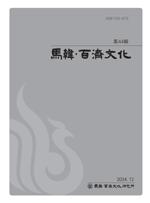- 영문명
- Visualization of Buddhist Ritual and Monastic Projects in the 17th Century through the Muryangsa Gwaebul (1627)
- 발행기관
- 원광대학교 마한백제문화연구소
- 저자명
- 유경희(Kyung Hee Ryu)
- 간행물 정보
- 『마한백제문화』제45집, 158~179쪽, 전체 22쪽
- 주제분류
- 인문학 > 역사학
- 파일형태
- 발행일자
- 2025.06.30

국문 초록
본 연구는 1627년에 조성된 <무량사 괘불>을 중심으로, 조선 17세기 전반기 사찰 불사의 양상과 불교 의례의 시각화 방식을 고찰하였다. 임진왜란과 병자호란을 거치며 조선의 주요 사찰은 심각한 피해를 입었고, 무량사 역시 대부분의 전각이 소실되었다. 이에 따라 17세기 초부터 무량사의 승려 탁규를 중심으로 극락전 중건과 주존불 조성, 대형 괘불과 동종, 전패 등의 불사가 잇달아 추진되며 사찰의신앙적 중심성과 위상이 회복되었다. 특히 <무량사 괘불>의 조성 전후로 불사 전반을 주도한 백련대사 탁규는, 무량사의 불사와 신앙을 이끈 핵심적인 인물이었다. 그는 괘불 조성 시 ‘대사’로 기록되었으며, 이후 불상 봉안, 동종 주성, 전패 조성 등 30여 년에 걸친 불사 전반에서 계속해서 중심적 위상을유지하였다. 그의 문중은 소요태능, 능허당, 풍계, 표월사일 등으로 이어지는 무량사 계통의 선사 계열을 형성하며, 무량사가 17세기 이후 충청 불교의 핵심 거점으로 기능하는 데 기초를 놓았다.
<무량사 괘불>은 조성 시기상 현존 괘불 중 두 번째로 이른 예이며, 보관을 쓰고 연꽃봉오리를 든입상 미륵존불이라는 독특한 도상을 중심에 배치하고 있다. 이른바 ‘장엄신’ 도상으로 불리는 이 형식은 이후 충청권을 중심으로 확산되며 조선 중기 괘불 도상의 하나의 전형으로 자리 잡게 되었다. 본 괘불의 도상 중 미륵의 보관 내에 표현된 여성형 인물은 『불설관미륵보살상생도솔천경』에 묘사된 도솔천 정토의 미륵보살과 그 화현불 구조와 상응하며, 특히 보관 내부에 묘사된 다수의 화불과 여성형 인물상은 불국토적 세계관의 시각적 구현이라 할 수 있다. 괘불 도상의 구성은 단순한 상징을 넘어, 실제로는 의례적 기능과 신앙 실천을 위한 매개 장치로 기능하였다.
『영산대회작법절차』(1615)와 『오종범음집』(1661)에 나타난 괘불의 현괘 절차, 그리고 영산회·참회재 등 당대 불교의식의 작법 구조를 바탕으로 볼 때, <무량사 괘불>은 참회 경전을 중심으로 한 참경거불(懺經擧佛) 의식에서 사용되었을 가능성이 높다. 당시 속리산 법주사나 금산사 등에서도 미륵탱을 현괘했던 의례 상황은 괘불의 실제 활용이 교학적 규범과는 달리 유동적이었음을 보여주는 반증자료로 활용된다.
이러한 점에서 <무량사 괘불>은 조선 후기 괘불 도상의 형성과정에서 중요한 전환점에 위치하며, 불사, 도상, 신앙, 의례 실천이 한 점의 괘불 안에 응축된 종합적 불교 시각 유산으로 평가된다. 본 연구는 괘불에 대한 도상사적 분석이 반드시 의례사적 맥락과 함께 병행되어야 함을 강조하고자 하였으며, 향후괘불의 화기 분석, 의례 공간과의 관계, 지역 신앙 전통과의 상관성 등에 대한 후속 연구가 요청된다.
영문 초록
This study examines the visualization of Buddhist rituals and the nature of temple reconstruction projects in the early 17th century Joseon, focusing on the Muryangsa Gwaebul created in 1627. Following the devastations of the Imjin and Byeongja Wars, major temples across Joseon—including Muryangsa—suffered significant damage. In response, large scale reconstruction efforts were initiated from the early 1600s, centering around the monk Takgyu (琢)珪, who oversaw the rebuilding of Geungnakjeon Hall, the creation of a principal Buddha statue, the production of a monumental gwaebul, a temple bell, and ritual plaques (jeonpae). These efforts contributed to the restoration of Muryangsa's religious centrality and institutional prominence. Takgyu, later honored as Baengnyeon-daesa, was not only the abbot of Muryangsa but emerged as a key figure in the broader Buddhist community of Joseon. His name appears in the gwaebul's inscription as “daesa,” and he maintained a central role across successive projects for over three decades. His lineage formed the basis for a Seon tradition at Muryangsa, continuing through monks such as Soyot’aenŭng, Nŭnghŏdang, Punggye, and Pyowŏlsa’il, helping to establish Muryangsa as a pivotal Buddhist center in Chungcheong Province in the postwar era. The Muryangsa Gwaebul is the second oldest surviving gwaebul in Korea and is distinguished by its depiction of a standing Maitreya Bodhisattva holding a lotus bud and wearing an elaborate jeweled crown. This iconographic form, referred to as the “majestic deity” (jangŏmsin) type, gained popularity in the Chungcheong region and came to define one of the standard gwaebul types of the mid-Joseon period. Of particular note are the numerous female-faced miniature Buddhas depicted within Maitreya’s crown, which align with descriptions from the Bulsŏl gwan Mireuk bosal sangsaeng dosolch’ŏn kyŏng (Sutra on the Visualization of Maitreya Bodhisattva’s Rebirth in Tusita Heaven).
These visual elements serve as a manifestation of the Pure Land's cosmology and reinforce the doctrinal underpinnings of the painting. The gwaebul’s compositional structure thus functioned not only as symbolic imagery but also as a visual medium that facilitated ritual practice and religious devotion. Based on ritual manuals such as the Yŏngsandaehoe jakpŏp chŏlch’a (1615) and the Ojong pŏmŭm chip (1661), which detail procedures for displaying large Buddhist paintings in public rituals, the Muryangsa Gwaebul was likely used in repentance rituals (ch’amgyŏng kŏbul) centered on scriptures of contrition. Evidence from contemporaneous practices at Beopjusa and Geumsansa further suggests that the deployment of gwaebul was more flexible in actual usage than textual norms might imply. In this regard, the Muryangsa Gwaebul represents a critical turning point in the development of late Joseon gwaebul iconography. It is a comprehensive visual Buddhist artifact that integrates monastic reconstruction, iconography, devotional ideology, and ritual practice into a single pictorial composition. This study underscores the importance of interpreting gwaebul iconography within its ritual and institutional context, and calls for further research into inscriptional analysis, spatial deployment in ritual settings, and the interrelationship between regional devotional traditions and visual expression.
목차
Ⅰ. 머리말
Ⅱ. 17세기 무량사 불사 재건과 승려 탁규
Ⅲ. 무량사 괘불의 도상과 특징
Ⅳ. 무량사 괘불의 조성과 의례적 기능
Ⅴ. 맺음말
참고문헌
키워드
해당간행물 수록 논문
참고문헌
최근 이용한 논문
교보eBook 첫 방문을 환영 합니다!

신규가입 혜택 지급이 완료 되었습니다.
바로 사용 가능한 교보e캐시 1,000원 (유효기간 7일)
지금 바로 교보eBook의 다양한 콘텐츠를 이용해 보세요!




